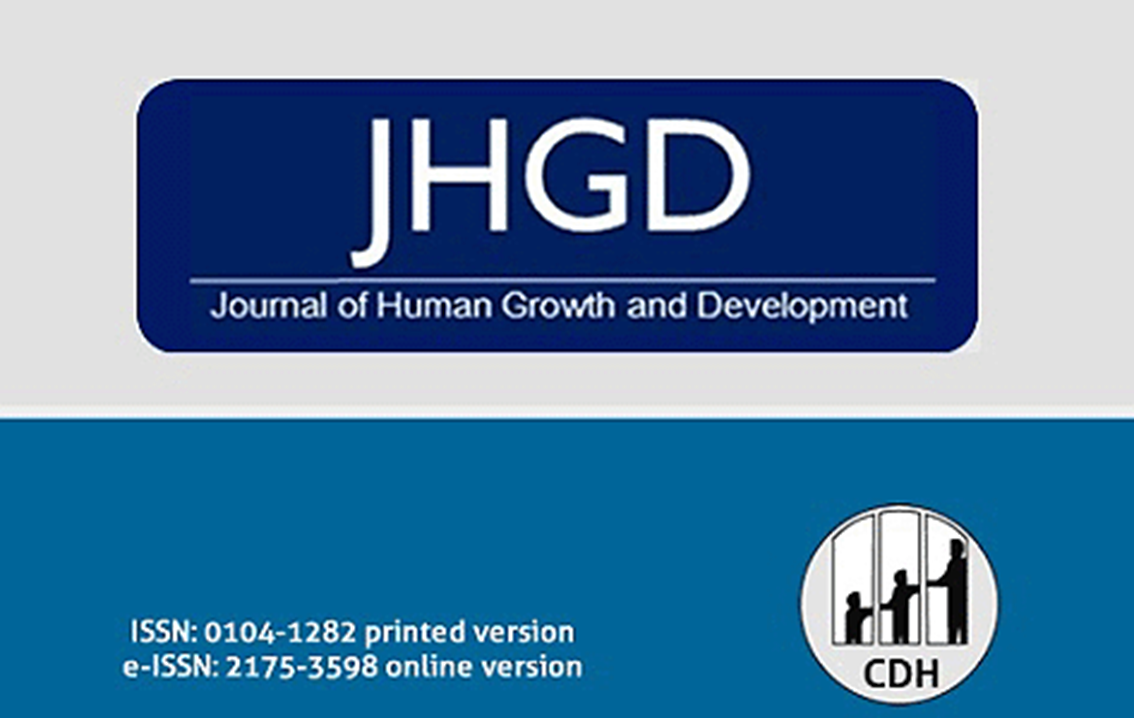Developmental coordination disorder in children enrolled in part time and full time Public Schools
DOI:
https://doi.org/10.7322/jhgd.v30.9959Keywords:
Children, Motor development, Motor difficulty, Full-Time SchoolAbstract
Introduction: Children with Developmental Coordination Disorder (DCD) are characterized by low motor proficiency unrelated to neurological disorders or severe intellectual impairment, which results in difficulties to perform tasks of daily living.
Objective: This study investigated the prevalence of potential DCD in children with a mean age of 8.1 ± 0.35 years in part-time and full-time public schools.
Methods: The sample consisted of 159 children, both sexes, being 48.4% of partial time and 51.6% from full time school. Movement Assessment Battery for Children, Second Edition (MABC-2) was used to assess aiming and catching skills, manual dexterity, and static and dynamic balance. Children were classified into: typical motor development, risk for DCD or potential DCD. For data analysis we used the Kolgomorov- Smirnov test. For comparisons of variables, the Mann Whitney U Test and analysis of variance were used to identify which skills evidenced the best levels of motor proficiency among the children.
Results: The results indicated that 2.5% of full-time school children were diagnosed with potential DCD and no occurrence among part-time school children, but with no statistically significant differences comparing skills according to daily school hours.
Conclusion: The sum of the prevalence of children at risk and potential DCD (18.3%) reports a concern, indicating a need for early motor development assessments to establish interventions to reverse or minimize motor deficit.
Downloads
References
2. Vaivre-Douret L. Developmental coordination disorders: state of art. Neurophysiol Clin. 2014;44(1):13-23. DOI: http://dx.doi.org/10.1016/j.neucli.2013.10.133
3. Valentini NC, Saccani R. Escala Motora Infantil de Alberta: validação para uma população gaúcha. Rev Paul Pediatr. 2011;29(2):231-8. DOI: http://dx.doi.org/10.1590/S0103-05822011000200015
4. Cantell MH, Smyth MM, Ahonen TP. Two distinct pathways for developmental coordination disorder: Persistence and resolution. Hum Mov Sci. 2003;22(4-5):413-31. DOI: http://dx.doi.org/10.1016/j.humov.2003.09.002
5. Henderson SE, Henderson L. Toward an understanding of developmental coordination disorder: terminological and diagnostic issues. Neural Plast. 2003;10(1-2):1-13. DOI: http://dx.doi.org/10.1155/NP.2003.1
6. Association AP. Diagnostic and statistical manual of mental disorders (DSM-5®): fifth edition. American Psychiatric Association, 2013.
7. Giagazoglou P, Kabitsis N, Kokaridas D, Zaragas C, Katartzi E, Kabitsis C. The movement assessment battery in Greek preschoolers: The impact of age, gender, birth order, and physical activity on motor outcome. Res Dev Disabil. 2011;32(6):2577-82. DOI: http://dx.doi.org/10.1016/j.ridd.2011.06.020
8. Cairney J, Hay JA, Faught BE, Hawes R. Developmental coordination disorder and overweight and obesity in children aged 9-14?y. Int J Obesity. 2005;29(4):369-72. DOI: http://dx.doi.org /10.1038/sj.ijo.0802893
9. Lingam R, Hunt L, Golding J, Jongmans M, Emond A. Prevalence of developmental coordination disorder using the DSM-IV at 7 years of age: a UK population–based study. Pediatrics. 2009;123(4):e693-700. DOI: http://dx.doi.org/10.1542/peds.2008-1770
10. Valentini NC, Coutinho MTC, Pansera SM, Santos VAP, Vieira JLL, Ramalho MH, et al. Prevalência de déficits motores e desordem coordenativa desenvolvimental em crianças da região Sul do Brasil. Rev Paul Pediatr. 2012;30(3):377-84. DOI: http://dx.doi.org/10.1590/S0103-0582201200030001
11. Miranda TB, Beltrame TS, Cardoso FL. Desempenho motor e estado nutricional de escolares com e sem transtorno do desenvolvimento da coordenação. Rev Bras Cineantropom Desempenho Hum. 2011;13(1):59-66. DOI: http://dx.doi.org/10.5007/1980-0037.2011v13n1p59
12. Souza C, Ferreira L, Catuzzo MT, Corrêa UC. O teste ABC do movimento em crianças de ambientes diferentes. Rev Port Cien Desp. 2007;7(1):36-47.
13. Santos VAP, Vieira JLL. Prevalência de desordem coordenativa desenvolvimental em crianças com 7 a 10 anos de idade. Rev Bras Cineantropom Desempenho Hum. 2013;15(2):233-42. DOI: http://dx.doi.org/10.5007/1980-0037.2013v15n2p233
14. Melo TMFM, Kubota AMA, Almeida PHTQ, Pontes TB. Influência da educação integral na prevalência de transtorno do desenvolvimento da coordenação em crianças em idade escolar. Cad Ter Ocup UFSCar. 2014;22(3):537-42. DOI: http://dx.doi.org/10.4322/cto.2014.075
15. Henderson SE, Sugden DA, Barnett AL. Movement assessment battery for children-2. Harcourt Assessment, 2007.
16. Valentini N, Ramalho M, Oliveira M. Movement Assessment Battery for Children-2: Translation, reliability, and validity for Brazilian children. Res Dev Disabil. 2014;35(3):733-40. DOI: http://dx.doi.org/10.1016/j.ridd.2013.10.028
17. Geuze RH, Jongmans MJ, Schoemaker MM, Smits-Engelsman BC. Clinical and research diagnostic criteria for developmental coordination disorder: a review and discussion. Hum Mov Sci. 2001;20(1-2):7-47. DOI: http://dx.doi.org/10.1016/S0167-9457(01)00027-6
18. França C. Desordem Coordenativa Desenvolvimental em crianças de 7 e 8 anos de idade. Dissertação (Mestrado) - Centro de Ciências da Saúde e do Esporte da Universidade do Estado de Santa Catarina. Florianópolis: 2008.
19. Missiuna C, Moll S, King S, King G, Law M. A trajectory of troubles: parents' impressions of the impact of developmental coordination disorder. Phys Occup Ther Pediatr. 2007;27(1):81-101. DOI: http://dx.doi.org/10.1080/J006v27n01_06
20. Silva EVA, Contreira AR, Beltrame TS, Sperandio FF. Programa de intervenção motora para escolares com indicativo de transtorno do desenvolvimento da coordenação-TDC. ?Re. Bras Educ Espec. 2011;17(1):137-50. DOI: http://dx.doi.org/10.1590/S1413-65382011000100010
21. Chow SM, Henderson SE, Barnett AL. The Movement Assessment Battery for Children: A comparison of 4-year-old to 6-year-old children from Hong Kong and the United States. Am J Occup Ther. 2001;55(1):55-61. DOI: http://dx.doi.org/10.5014/ajot.55.1.5
22. Smits-Engelsman BC, Niemeijer AS, van Galen GP. Fine motor deficiencies in children diagnosed as DCD based on poor grapho-motor ability. Hum Mov Sci. 2001;20(1-2):161-82. DOI: http://dx.doi.org/10.1016/S0167-9457(01)00033-1
23. Niemeijer AS, Smits?Engelsman BC, Schoemaker MM. Neuromotor task training for children with developmental coordination disorder: a controlled trial. Dev Med Child Neurol. 2007;49(6):406-11. DOI: http://dx.doi.org/10.1111/j.1469-8749.2007.00406.x






